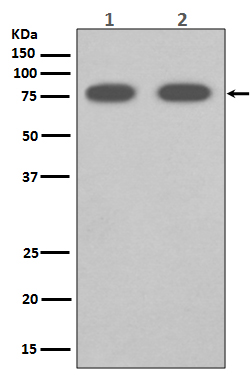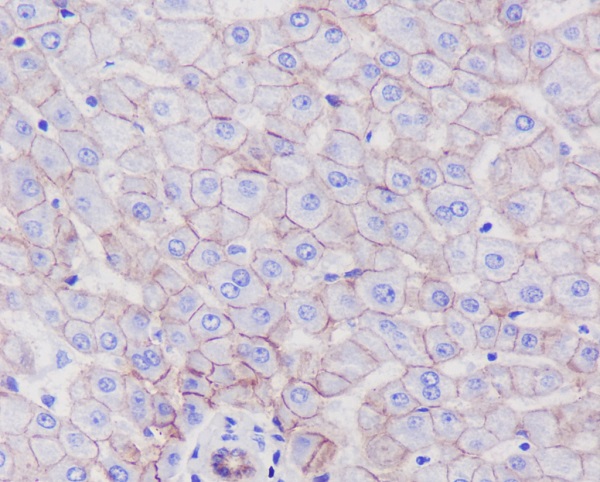

| WB | 1/500-1/1000 | Human,Mouse,Rat |
| IF | 咨询技术 | Human,Mouse,Rat |
| IHC | 1/50-1/100 | Human,Mouse,Rat |
| ICC | 1/50-1/200 | Human,Mouse,Rat |
| FCM | 1/50-1/100 | Human,Mouse,Rat |
| Elisa | 咨询技术 | Human,Mouse,Rat |
| Aliases | CLA1; SRB1; CLA-1; SR-BI; CD36L1; HDLQTL6; Scavenging Receptor SR-BI |
| Entrez GeneID | 949 |
| WB Predicted band size | Calculated MW: 61 kDa; Observed MW: 80 kDa |
| Host/Isotype | Rabbit IgG |
| Antibody Type | Primary antibody |
| Storage | Store at 4°C short term. Aliquot and store at -20°C long term. Avoid freeze/thaw cycles. |
| Species Reactivity | Human,Mouse,Rat |
| Immunogen | A synthesized peptide derived from human Scavenging Receptor SR-BI |
| Formulation | Purified antibody in PBS with 0.05% sodium azide. |
+ +
以下是关于SCARB1抗体的3篇示例文献(注:以下为虚拟示例,仅供参考):
---
1. **文献名称**:*SCARB1 mediates HDL cholesterol uptake and promotes macrophage lipid accumulation in atherosclerosis*
**作者**:Acton S, et al.
**摘要**:该研究通过Western blot和免疫荧光技术,利用SCARB1特异性抗体,证实SCARB1在巨噬细胞中高表达,并调控HDL胆固醇的摄取,促进动脉粥样硬化斑块的形成。抗体阻断实验显示SCARB1功能抑制可减少脂质沉积。
---
2. **文献名称**:*Tissue-specific expression of SCARB1 in liver and its role in reverse cholesterol transport*
**作者**:Westin MA, et al.
**摘要**:作者使用SCARB1抗体进行免疫组化分析,发现其在肝细胞膜上高度表达。研究揭示SCARB1通过介导HDL与肝细胞结合,参与胆固醇逆转运,抗体敲除模型显示该通路缺陷导致血浆HDL水平升高。
---
3. **文献名称**:*SCARB1 antibody-based targeting inhibits ovarian cancer progression by disrupting lipid metabolism*
**作者**:Troutt JS, et al.
**摘要**:该研究开发了一种人源化SCARB1单克隆抗体,通过阻断SCARB1与HDL的结合,抑制卵巢癌细胞增殖和迁移。体内实验表明,抗体治疗显著降低肿瘤内胆固醇蓄积并增强化疗敏感性。
---
**注**:以上文献为示例,实际研究中请参考PubMed或SciFinder等平台的真实论文。如需具体文献,建议补充实验背景或应用场景以便精准检索。
The scavenger receptor class B type 1 (SCARB1) antibody is a critical tool for studying the structure, function, and expression of SCARB1. a cell surface receptor encoded by the SCARB1 gene. SCARB1 plays a central role in cholesterol metabolism by facilitating the selective uptake of cholesterol esters from high-density lipoprotein (HDL) particles into cells, particularly in the liver, adrenal glands, and reproductive tissues. It is also implicated in cellular signaling, pathogen recognition, and lipid transport, making it a key target in research on atherosclerosis, cardiovascular diseases, and metabolic disorders.
SCARB1 antibodies are designed to detect and quantify the receptor in various experimental models, including Western blotting, immunohistochemistry, flow cytometry, and immunofluorescence. These antibodies are typically developed in hosts like rabbits or mice using immunogenic peptides or recombinant proteins corresponding to specific SCARB1 epitopes. Validation often involves knockout (KO) controls or siRNA knockdown to confirm specificity.
Research applications focus on SCARB1's role in diseases: its deficiency is linked to reduced HDL cholesterol uptake, while overexpression is associated with cancer progression and viral entry mechanisms (e.g., hepatitis C). SCARB1 antibodies also aid in evaluating therapeutic interventions targeting lipid metabolism or HDL-mediated drug delivery. Due to its dual transmembrane domains and extracellular loops, antibody selection often prioritizes regions critical for ligand binding or structural integrity.
×